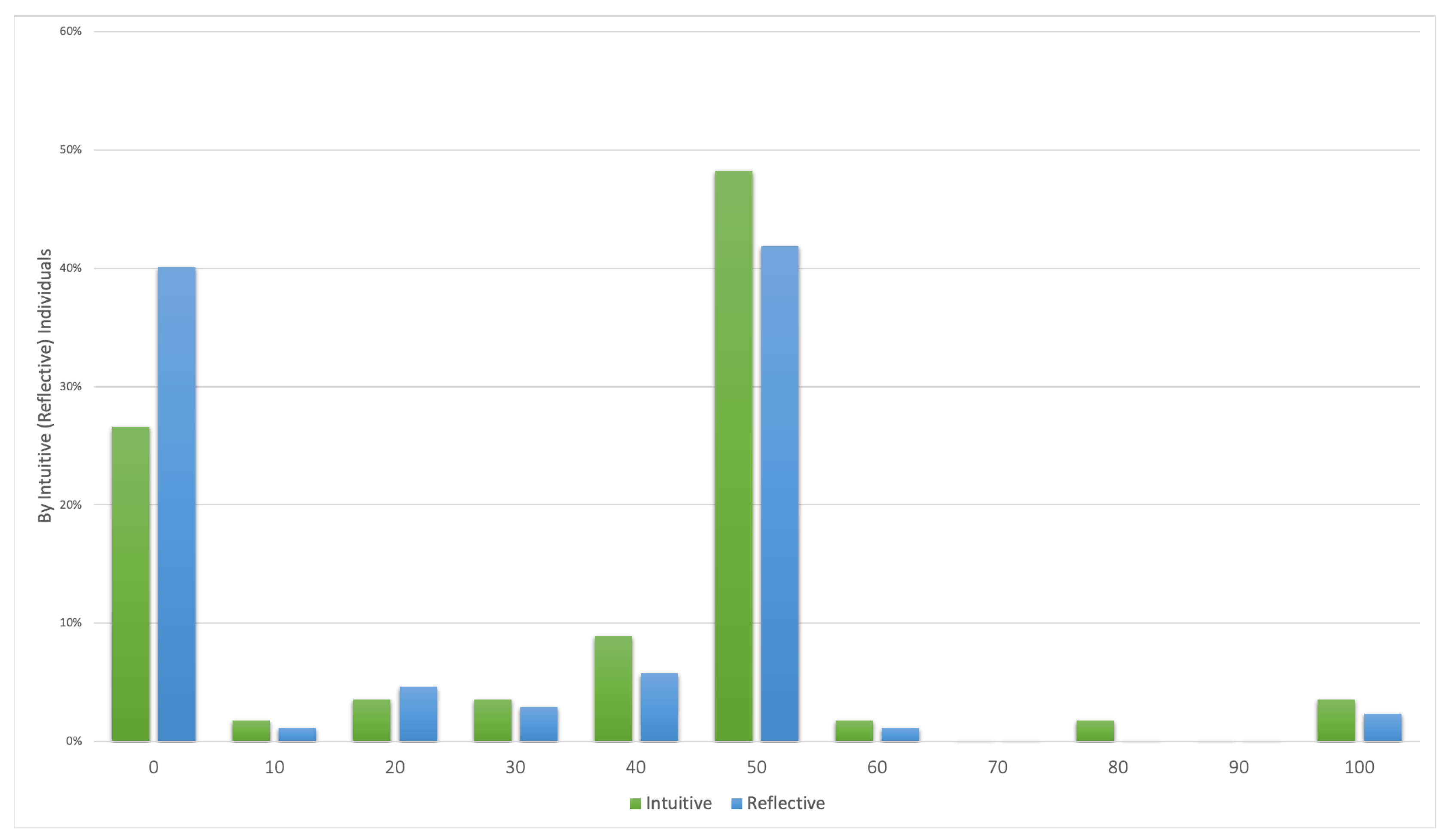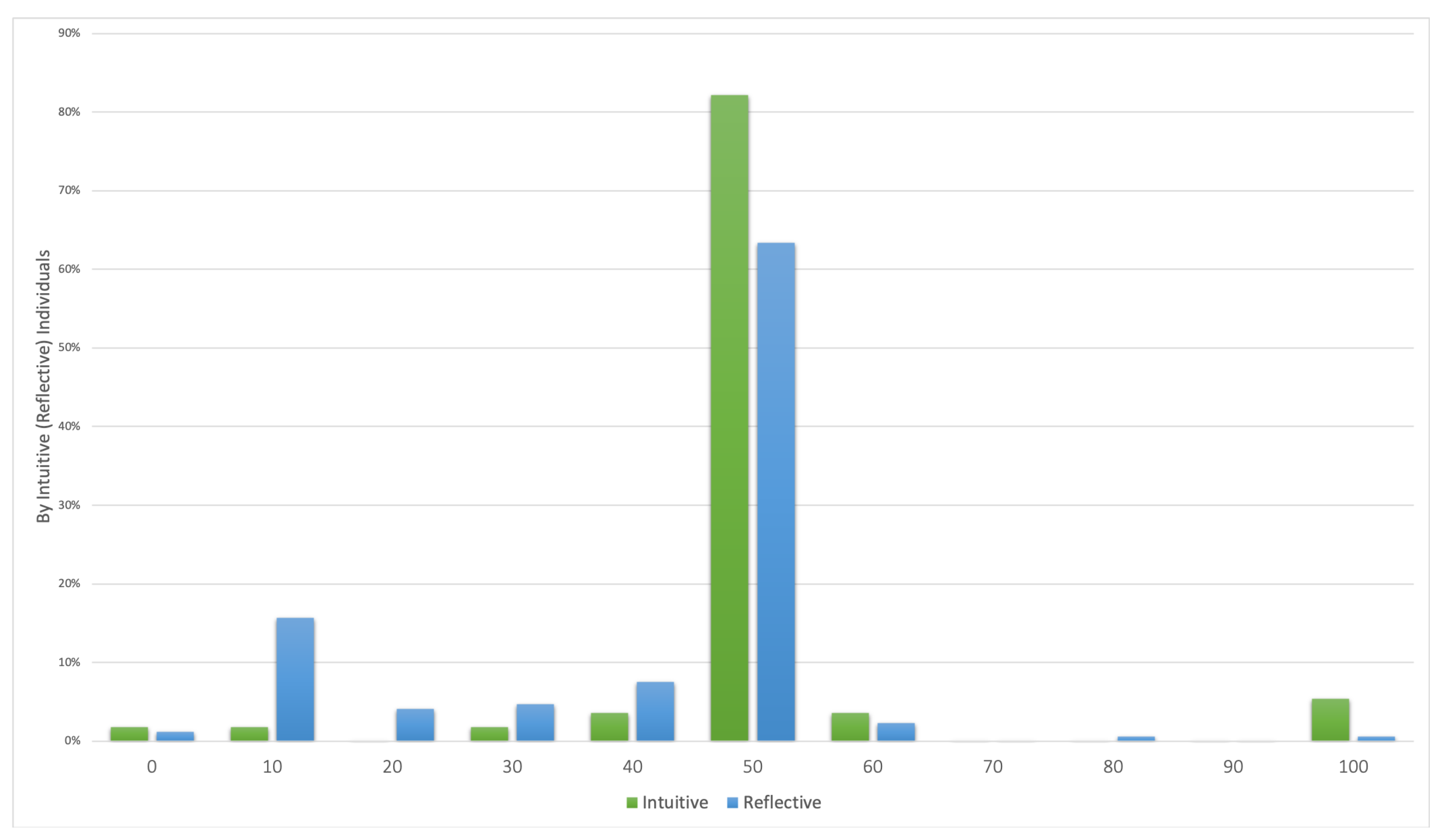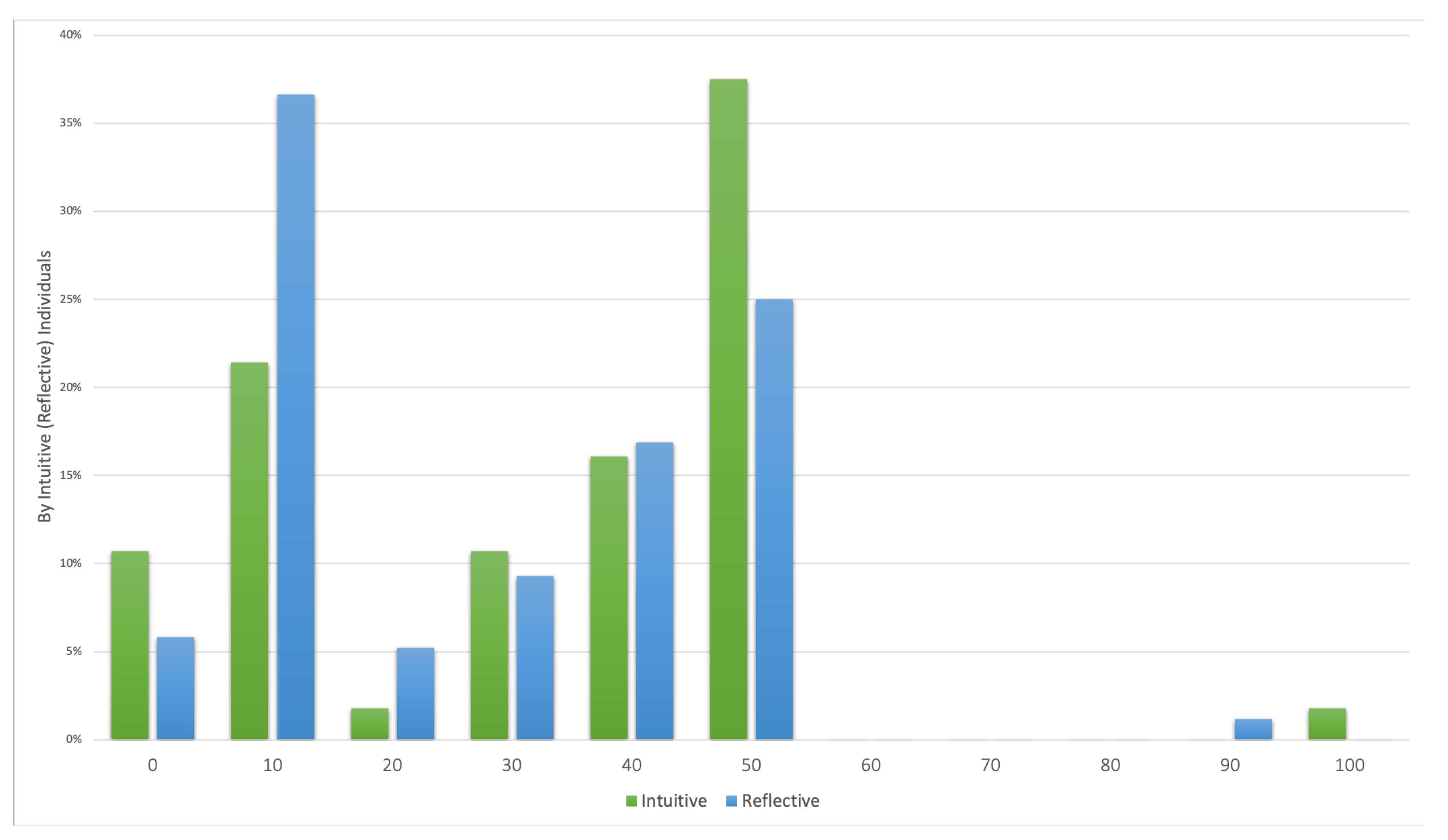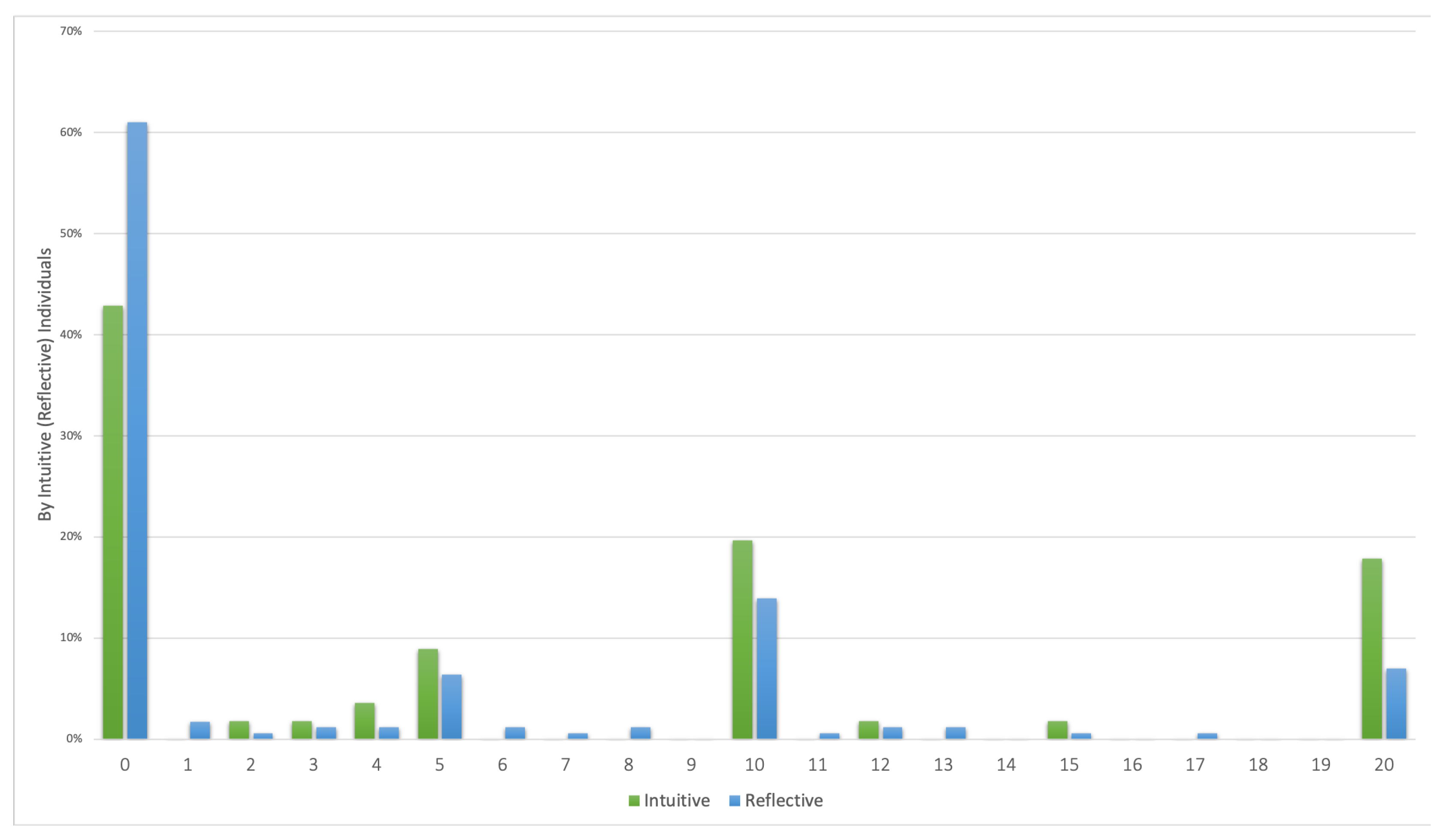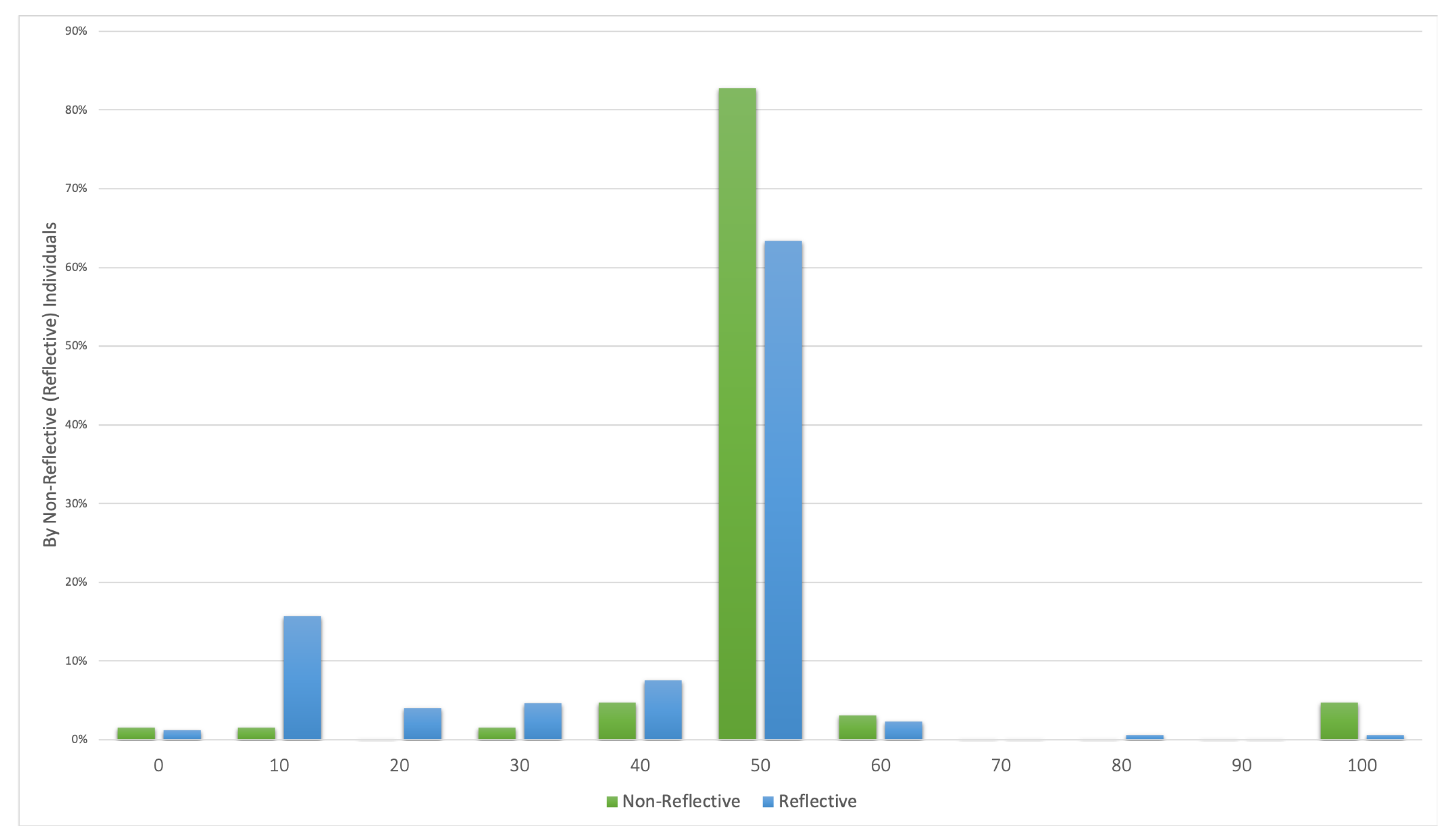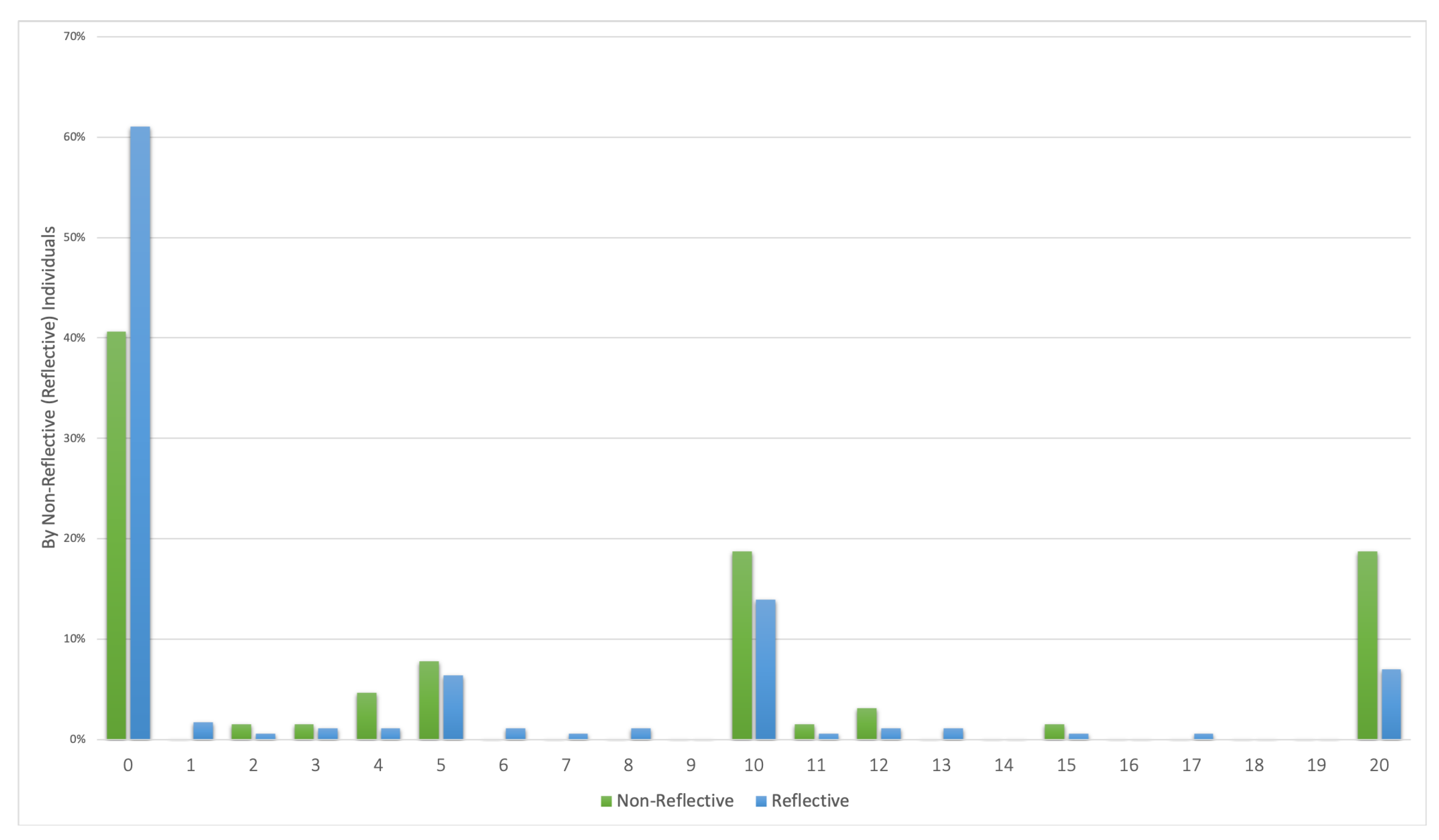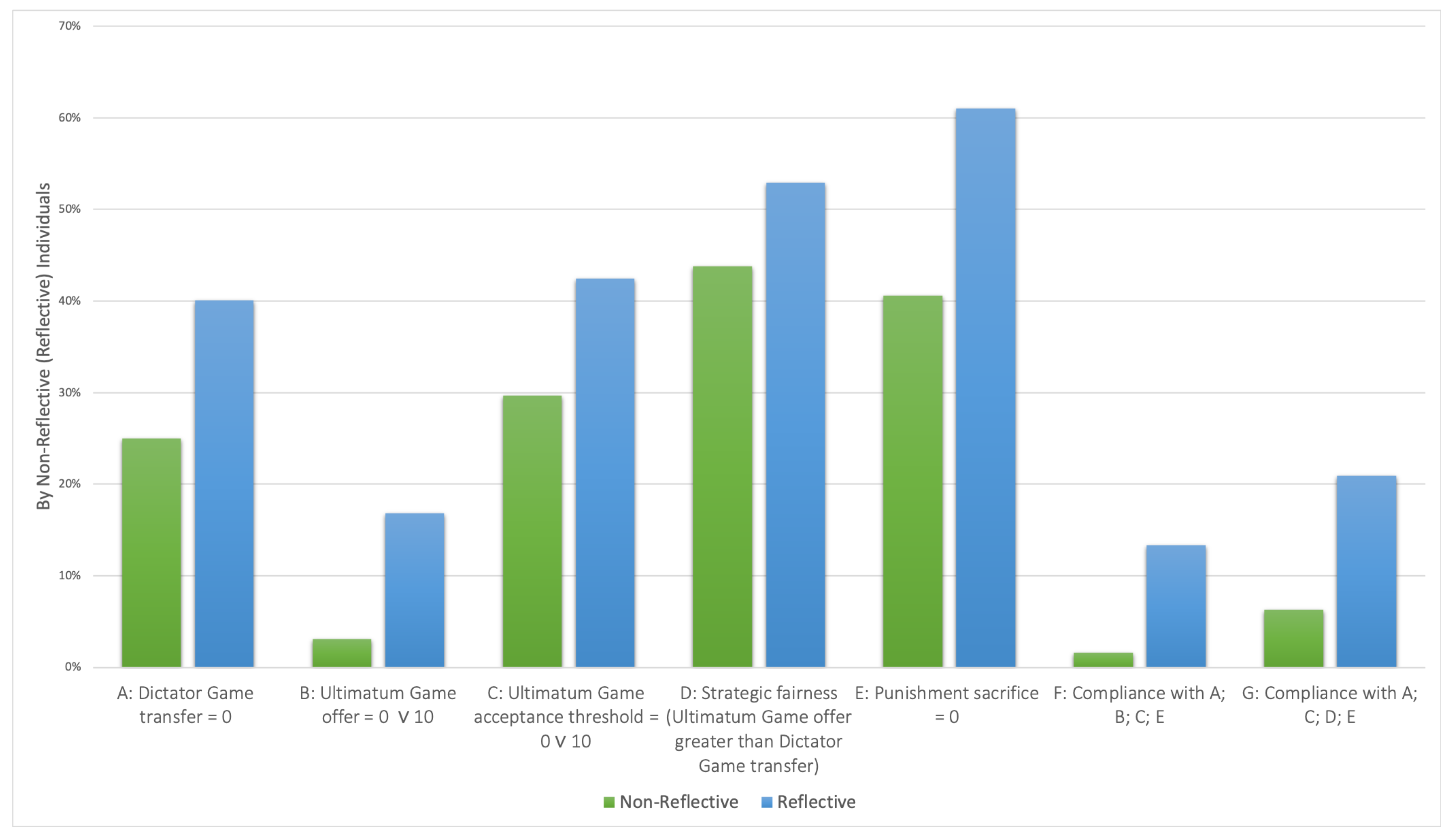1. Introduction
Human societies depend on their members acting cooperatively. Social sanctioning is crucial for the maintenance of cooperative behavior when there exist material incentives to deviate from collectively desirable behavior, such as benefiting from a public good without bearing the cost of contributing. Sanctioning behavior can be explained by strong reciprocity, which is defined by a willingness to sacrifice resources to reward cooperative actions and to punish hostile actions even when this is costly and provides neither present nor future material rewards for the reciprocator [
1,
2]. Thus, individuals acting as norm enforcers enable cooperative behavior because of an understanding and expectation that a deviation will be sanctioned [
3]. Social dilemma experiments reveal a great deal of strong reciprocity. For example, in [
4], the majority of subjects were willing to engage in
third-party punishment. That is, they punished a hostile action even though it did not affect their personal earnings.
Is sanctioning a norm violation an intuitive response, or does it take deliberation to sacrifice resources? To the best of my knowledge this question has not been investigated in the context of third-party punishment, where there is no indirect benefit from sanctioning through reputation-building or long-term material incentives from changing the behavior of people one interacts with in the future.
More generally, is cooperative behavior driven by an
intuitive response or due to
deliberation? Whether individuals rely on
intuition or
reflection in social dilemma experiments has been shown to generate differences in behavior. Applying cognitive reflection tests [
5,
6], subjects relying on
intuition in decision-making are found to act more prosocially [
7,
8,
9,
10,
11].
I contribute to this literature by examining whether behavior is consistent across three games and whether sanctioning the violation of a norm is an intuitive action. Applying a third-party punishment task, subjects are given the opportunity to, at a personal cost, sanction another subject who kept the entire endowment to herself in the dictator game.
Studying subjects’ response time has as well been applied to access whether individuals rely on
intuition in decision-making. Results in these studies are, however, not conclusive about whether a faster response time indicate more prosocial [
12] or more egoistic [
13] behavior. Identifying whether a choice is
intuitive or
deliberate from response time suffers from endogeneity issues as various cognitive processes contribute to response time. When controlling for strength-of-preference, there is no evidence that one type of choice is systematically faster than the other [
14].
According to the Social Heuristic Hypothesis,
intuitive individuals behave more prosocially in the lab because they internalize generally beneficial behavior from daily life that favors cooperative and fair behavior [
15]. In light of this, the employed experimental design in this study investigates how strong these internalized fairness preferences are.
The purpose of this study is twofold. By having subjects complete the
dictator game, the
ultimatum game (both in the role of
proposer and
recipient) and finally the
third-party punishment task the purpose is first to see if subjects display consistent behavior across games in line with the hypothesis that the “fair” outcome drives
instinctive choices but that it takes
deliberation to act selfishly. Secondly, this experiment investigates for the first time if the
instinctive action is to engage in
third-party punishment toward a
dictator who kept the entire endowment to herself in the
dictator game. The subjects’ tendency to rely on
intuition in decision-making is assessed by Frederick’s three-item Cognitive Reflection Test (CRT) [
5].
The sample consists of 295 students at Aarhus University, collected during spring 2019.
The results of this study confirmed, first of all, previous findings that reflective subjects act more selfishly and in accordance with the economic prediction in the dictator- and ultimatum games. They transferred less in dictator game, they offerred less as the proposer in the ultimatum game, and they were more likely to accept a low offer as recipient. Secondly, the experiment extended previous findings to third-party punishment by showing that the intuitive action was to sanction a norm-violator. Subjects relying on intuition in decision-making were found more likely to sacrifice resources to sanction a dictator who kept the entire endowment to herself. Taken together, the results of this experiment provide evidence that the intuitive action is to engage in “fair” behavior, or to sanction those not complying with the social norm of fair behavior.
In the following
Section 2, I present the experimental design. The hypotheses are presented in
Section 3.
Section 4 presents the results of the experiment.
Section 5 provides a general discussion of the findings.
Section 6 discusses the limitations of this study.
Section 7 concludes.
3. Hypotheses
Looking to replicate previous findings of fair behavior by individuals relying on intuition in decision-making and that it takes reflection to pursue a self-interested objective gives three hypotheses in the dictator- and ultimatum game decisions.
Hypothesis 1. Reflective individuals transfer less in the dictator game compared to intuitive individuals.
Hypothesis 2. Reflective individuals offer less as proposer in the ultimatum game compared to intuitive individuals.
Hypothesis 3. Reflective individuals require a smaller share to accept the offer as ultimatum game recipient compared to intuitive individuals.
Including both the proposer decision in the ultimatum game and the transfer decision in the dictator game, it is possible to detect whether strategic considerations drive the ultimatum game offer. In the dictator game, such strategic considerations are absent, because it is a pure decision problem without strategic interaction. Expecting the intuitive action to be fair and reflection to lead to rational, self-interested decisions generates two hypotheses for proposer and dictator behavior.
Hypothesis 4a. Reflective individuals offer more in the ultimatum game relative to their transfer in the dictator game.
Hypothesis 4b. Intuitive individuals do not offer more in the ultimatum game relative to their transfer in the dictator game.
A main contribution of this study is the investigation of whether the intuitive action is to sanction those who violated the norm of fair behavior.
Hypothesis 5. Intuitive individuals exhibit a greater willingness to punish a selfish dictator than reflective individuals.
The other contribution to the existing literature is that this study investigates the behavior across four social dilemma decisions.
Hypothesis 6. Reflective individuals act consistently more rational and self-interested in the four social dilemma decisions compared to intuitive individuals.
4. Results
A total of 295 subjects completed the study. The main sample consists of 236 observations, for which all variables of interest are available. Of the 236 subjects in the main sample, 124 were male subjects (one subject did not state gender). 214 of the subjects were students at the faculty of Business and Social Sciences at Aarhus University, which leaves a minority from other faculties. This is not surprising, because the courses where the study was advertised are available in the faculty of Business and Social Sciences.
In each task, a few subjects chose the opposite extreme of strict self-interest (transferring DKK 100 in the dictator game and offering DKK 100 in the ultimatum game and accepting no less than DKK 100 in the ultimatum game). These “outliers” are included in the analysis. Excluding them does not alter the findings.
4.1. Cognitive Reflection Test Results
On average, the subjects answered of the items on the CRT correctly. Of the 236 subjects, answered all three items correctly, answered two correctly, answered one correctly and did not answer any of the three items correctly. of the subjects opted for the intuitive incorrect answer in all three items, chose the intuitive answer in at least two items and chose the intuitive incorrect answer at least once.
The
reflective group consists of 172 subjects. The
intuitive group consists of 56 subjects. The residual group consists of 8 subjects. As the residual group consists only of 8 subjects, these are grouped with the
intuitive subjects throughout the statistical analysis. Therefore, the analyses mainly compares those
reflective to those not
reflective. The
non-reflective group consists therefore of 64 subjects. Excluding the residual group, and thereby comparing the
reflective to the
intuitive subjects, does not change conclusions. (See
Appendix D (
Table A1,
Table A2,
Table A3,
Table A4,
Table A5 and
Table A6,
Figure A1,
Figure A2,
Figure A3,
Figure A4 and
Figure A5) for a summary of the findings excluding the residual group).
Men performed better in the CRT by answering an average of
items correctly compared to women with an average of
correct answers. This difference is statistically significant (
, MWU
2). The distribution of the answers can be found in
Appendix E (
Table A7,
Table A8,
Table A9,
Table A10 and
Table A11).
4.2. Dictator Behavior
Result 1: Reflective subjects transfer less in the dictator game than intuitive subjects.
Reflective subjects transfer on average less than those not reflective (average transfer of DKK and DKK , respectively). This difference is statistically significant at the significance level (, MWU).
The average amount transferred to the recipient in the dictator game was DKK . The modal transfer was DKK 50, which of the subjects chose, whereas of the subjects chose to keep the entire endowment to themselves.
Transferring 0 DKK to the
receiver and thus comply with the prediction from standard economic theory is more common for the
reflective subjects (
chose this versus
of the
non-reflective). This difference is statistically significant at the
level (
,
). However, a part of the difference can be contributed to gender: Males are found significantly more likely to transfer DKK 0 to the
receiver in the
dictator game Thus, it appears that acting selfish in the
dictator game is independent of being
reflective when controlling for gender. Gender seems to be the significant factor that predicts behavioral differences (see
Table 1).
4.3. Proposer Behavior in the Ultimatum Game
Result 2: Reflective subjects offer less in the ultimatum game than intuitive subjects.
Reflective subjects offer on average less than those not reflective (average offer of DKK and DKK , respectively). This difference is statistically significant (, MWU).
The average offer in the ultimatum game was DKK . The most frequently offered amount was DKK 50, which of the subjects chose.
Of the reflective subjects, offered DKK 10. Only one subject () from the intuitive group offered DKK 10.
Distinguishing whether the recipient accepts or rejects an offer when indifferent, both offers of DKK 0 and DKK 10 can be considered consistent with rational and strictly self-interested behavior. of the reflective subjects chose either of these offers as opposed to of the non-reflective. This difference is statistically significant (, ).
When controlling for gender,
reflective subjects are estimated to be
-points more likely than
non-reflective subjects to offer DKK 0 or DKK 10 in the
ultimatum game.
Reflective subjects are predicted to choose such an offer with a probability of
as opposed to a predicted probability of
for those
non-reflective (see
Table 1).
4.4. Recipient Behavior in the Ultimatum Game
Result 3: Reflective subjects are willing to accept lower offers in the ultimatum game than intuitive subjects.
Reflective subjects have on average a lower acceptance threshold relative to those not reflective (average threshold of DKK and DKK , respectively). This difference is statistically significant at the significance level (, MWU).
The average acceptance threshold was DKK . The modal acceptance threshold was DKK 10 and was chosen by of the subjects whereas DKK 50 (requiring an equal split) was chosen by of the subjects.
For the reflective subjects, the modal acceptance threshold was DKK 10, which was chosen by in this category as opposed to in the intuitive category. The modal acceptance threshold for the intuitive subjects was DKK 50, which was chosen by in this category as opposed to in the reflective category.
Both an acceptance threshold of DKK 0 or DKK 10 can be considered the rational, self-interested choice.
of the
reflective subjects chose one of these thresholds as opposed to
of the
non-reflective subjects. This difference is statistically significant at the
significance level (
,
). When controlling for gender,
reflective subjects are estimated to be
-points more likely, compared to
non-reflective subjects, to choose an acceptance threshold of DKK 0 or DKK 10 as
recipient in the
ultimatum game.
Reflective subjects are predicted to choose such an acceptance threshold with a probability of
as opposed to a predicted probability of
for those
non-reflective (see
Table 1).
4.5. Dictator/Proposer Comparison
Result 4: Both reflective and intuitive subjects increase their offer in the ultimatum games relative to their transfer in the dictator game.
Across all subjects, the average transfer in the dictator game was DKK and the average offer in the ultimatum game was DKK . Applying a Wilcoxon Sign Rank test, these means are significantly different (). Applying the test when distinguishing between reflective and intuitive subjects yields the same conclusion (). Thus, both the reflective and intuitive subjects increase their offer in the ultimatum game relative to their transfer in the dictator game.
More than half of the subjects () chose to increase their offer in the ultimatum game compared to their transfer in the dictator game—exhibiting strategic fairness. of the reflective and of the non-reflective subjects opted for this decision. This difference is not statistically significant (, ).
When controlling for gender,
reflective subjects are estimated to be
-points more likely to exhibit strategic fairness than
non-reflective subjects. However, the effect is not statistically significant.
Reflective subjects are predicted to exhibit strategic fairness with a probability of
as opposed to a predicted probability of
for those
non-reflective (see
Table 1).
4.6. Third-Party Punishment Behavior
Result 5: Intuitive subjects are more likely to punish a selfish dictator than reflective subjects.
Of the 236 subjects, 105 chose to punish the dictator, who kept the entire endowment to herself. The average amount sacrificed was DKK which implies that a selfish dictator, on average, had her income reduced by DKK 24. The modal amount sacrificed was DKK 0, which of the subjects chose. of the subjects chose to reduce the earnings of the selfish dictator to DKK 0 by sacrificing DKK 20 of their endowment. of the subjects chose to reduce the dictator’s earnings by DKK 50 leaving the dictator with half of her initial endowment.
of the intuitive subjects chose to punish as opposed to of the reflective subjects. This difference is statistically significant (, ). The reflective subjects sacrificed, on average, DKK as opposed to DKK sacrificed by intuitive subjects. This difference is statistically significant (, MWU). Comparing the reflective subjects to those not reflective yields the same conclusion.
Considering only the subjects who opted for the opportunity to punish the selfish dictator, the intuitive subjects sacrificed, on average, DKK as opposed to DKK by the reflective subjects. This difference is not statistically significant (, MWU).
When controlling for gender,
reflective subjects are estimated to be
-points more likely to not punish the dictator than
non-reflective subjects.
Reflective subjects are predicted to not engage in
third-party punishment with a probability of
as opposed to a predicted probability of
for those
non-reflective (see
Table 1).
4.7. Consistency in Choices
Result 6: Reflective subjects are more likely to act consistently and in line with rational, self-interested behavior across all social dilemma tasks compared to intuitive subjects.
A rather clear prediction for rational, self-interested behavior exists for the dictator game, recipient’s acceptance threshold in the ultimatum game, and the third-party punishment task. However, the decision as proposer in the ultimatum game is rather difficult to classify as expectations for the decision of the recipient matter. Thus, any offer can be considered rational, self-interested if that is the lowest amount the proposer expects to be accepted.
Due to the ambiguity in what constitutes rational, self-interested behavior in the ultimatum game proposer decision, I will consider offering DKK 0 or DKK 10 and strategic fairness separately.
First I consider whether reflective subjects are more likely to transfer DKK 0 in dictator game, offer DKK 0 or DKK 10 as proposer in the ultimatum game, acceptance threshold of DKK 0 or DKK 10 as recipient in the ultimatum game and not opting for the punishment opportunity in the third-party punishment task.
of the
reflective subjects complied with the above-mentioned as opposed to
of those not
reflective. This difference is statistically significant (
,
). When controlling for gender,
reflective individuals are predicted to be
-points more likely than
non-reflective subjects to choose as described in these tasks.
Reflective subjects are predicted to choose as described with a probability of
as opposed to a predicted probability of
for those
non-reflective (see
Table 1).
A rational, self-interested individual could, as
proposer in the
ultimatum game, offer any share to the
recipient if this is what the
proposer believes to be the lowest amount to be accepted. However, in the
dictator game there is no scope for such strategic considerations why a rational, self-interested individual would offer more as
proposer in the
ultimatum game relative to the transfer in
dictator game. Considering whether
reflective subjects are more likely to transfer DKK 0 in
dictator game, have an acceptance threshold of DKK 0 or DKK 10 in the
ultimatum game, exhibit strategic fairness as
proposer in the
ultimatum game and not opting for the
punishment opportunity in the
third-party punishment task, I find this to be the case.
of the
reflective subjects complied with the above-mentioned as opposed to
of those not
reflective. This difference is statistically significant (
,
). When controlling for gender,
reflective subjects are predicted to be
-points more likely than
non-reflective subjects to choose as described in these tasks.
Reflective subjects are predicted to choose as described with a probability of
as opposed to a predicted probability of
for those
non-reflective (see
Table 1).
5. Discussion
In line with several other studies, this study found more rational, self-interested behavior among more reflective individuals and more prosocial behavior among intuitive individuals. Further, this study found the more prosocial behavior among intuitive individuals to carry over to the third-party punishment task, where these individuals were found more likely to sanction a selfish act. A contribution of the present study was that subjects were to complete multiple social dilemma task, which allows to investigate the consistency across choices. In this aspect, reflective individuals were found more likely to act rationally in accordance with their self-interest across all four decisions.
Intuitive subjects give more in the
dictator game, which is consistent with the findings of [
7]. Transferring a positive amount to the
receiver in the
dictator game could be interpreted as altruistic preferences [
2]. However, the findings of more rational and self-interested behavior by
reflective subjects should be interpreted carefully, as gender seems to be the significant factor that drives differences in behavior in the
dictator game. This is consistent with the findings of women giving more in a meta study on the experiments testing for gender differences [
18].
In the
ultimatum game,
reflective subjects offered less than those not
reflective. The decision of the
proposer can be explained either by a “taste for fairness” or a “fear of rejection” (or a combination of these motives) [
22]. Including the
dictator game allows the inference with which motive matters for which group. However, the results indicate that both groups seem to act on a “fear of rejection”. These findings contradict the findings of difference in transfer/offer being driven mostly by
reflective individuals [
10]. Even though “strategic fairness” appears to exist among both groups, the offers of the
intuitive individuals are larger than those of the
reflective. Thus,
intuitive individuals appear to expect their offers in the
ultimatum game to more likely be rejected. This is consistent with the consensus effect [
23].
Intuitive individuals require a larger amount to accept an offer themselves.
Reflective subjects are more likely to accept offers in the
ultimatum game, which confirms the findings of [
8,
9]. In those studies, the “strategy method” was not applied to the recipient’s decision. Thus,
reflective individuals exhibit a greater willingness to accept an unfair
ultimatum game offer even when they are not directly faced with and possibly offended by the offer. Whether or not the strategic version of the
ultimatum game induces lower acceptance thresholds is to some degree addressed in [
24]. In this study, besides from playing the extensive form of the game, the subjects were required to state the minimum offer she would be willing accept. They found a significant negative correlation between the acceptance threshold and proposed offer which can be interpreted in light of
reflective behavior. These individuals understand the bargaining position of the game as well as the risk of being rejected. Considering “negative reciprocity” as the motive for rejecting unfair offers in the
ultimatum game,
reflective individuals are more capable of overcoming their
intuitive desire to
punish the selfish act by the
proposer. The willingness to accept an unfair offer is related to the ability to reflect further upon the decision and realize that accepting the offer is the better option.
Intuitive subjects are more likely to engage in third-party punishment and reflective subjects appear again more likely to act rational and self-interested. Thus, intuitive individuals are interpreted to be more likely to act reciprocally.
6. Limitations
Some factors related to the experimental design may have influenced how subjects behaved.
As the link to the survey were distributed at lectures encouraging students to participate, it is unknown when, where and possibly with whom the subjects completed the survey. Hence, there is concerns regarding their anonymity. Considering the relatively high share of correct answers in the CRT, one could expect subjects to have communicated with each other or have accessed the internet to look up the correct answer. Further, the chances of receiving payment for completing the CRT depended on the number of correct answers, which might have further incentivized subjects to look up the correct answer - at least incentivized them to think more carefully about the question, which was unintended. These limitations question whether the categorization of subjects is reliable. A reasonable explanation for the relatively high share of correct answers on the CRT in this study is the test’s correlation with math abilities [
5]. The vast majority of subjects were students of Economics, Political Science or Psychology. Especially students of Economics are expected to be relatively more capable of math. The survey questions did not elicit from which education the subjects were enrolled.
Only seven of the 295 subjects who completed the study received payment, providing only weak incentives. However, the observations here fit rather well the observations from other studies with stronger economic incentives. In a meta study, the average transfer was found to be
of the endowment [
18], which is not far from
observed in this study. In a meta study on the ultimatum game, subjects were found to offer
of the endowment on average [
17], which is comparable to the
observed here.
Further, around of the subjects who started completing the survey opted out before the final question. Not being able to control the condition under which the survey was completed increases the probability of subjects sabotaging the experiment by choosing randomly or not reading through the instructions thoroughly. However, including or excluding the “outliers” of the present study did not change results.

